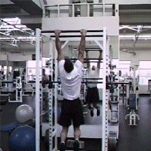Muscle-up on:
[Wikipedia]
[Google]
[Amazon]

 The muscle-up (also known as a muscleup or muscle up) is an intermediate
The muscle-up (also known as a muscleup or muscle up) is an intermediate

 The muscle-up (also known as a muscleup or muscle up) is an intermediate
The muscle-up (also known as a muscleup or muscle up) is an intermediate strength training
Strength training, also known as weight training or resistance training, is exercise designed to improve physical strength. It is often associated with the lifting of Weightlifting, weights. It can also incorporate techniques such as bodyweigh ...
exercise within the domain of calisthenics. It is a combination routine of a radial pull-up followed by a dip. Variations exist for the rings as well as the bar.
Form
The muscle-up begins with the arms extended above the head, gripping a hold in the overhand pull-up position. The hold is usually on a chin-up bar or gymnastic rings. The body is then explosively pulled up by the arms in a radial pull-up, with greater speed than a regular pull-up. When the bar approaches the upper chest, the wrists are swiftly flexed to bring the forearms above the bar. The body is leaned forward, and the elbows are straightened by activating the triceps. The routine is considered complete when the bar is at the level of the waist and the arms are fully straight. To dismount, the arms are bent at the elbow, as in a dip, and the body is lowered to the floor, and the exercise can be repeated. As a relatively advanced exercise, muscle-ups are typically first learned with an assistive kip. The legs swing (kip) up and provide momentum to assist in the explosive upward force needed to ascend above the bar. More advanced athletes can perform a strict variation of the muscle-up which is done slowly, without any kip. This variation begins with a swinging dead hang (or by standing still, with feet further forward than the bar, if the person's feet can touch the ground) and uses muscle contraction to ascend above the bar in an explosive yet controlled fashion.Grip and wrist position
A closed pull-up grip involves the thumb on the opposite side of the bar from the rest of the fingers. When rings are used, an advanced position known as the "false grip" must be performed in order to transition smoothly from the pull-up to the dip.Muscles targeted
True to its name, the muscle-up targets a large number of muscle groupings in the back, shoulders, arms, and core. Major pull-up power comes from thelatissimus dorsi muscle
The latissimus dorsi () is a large, flat muscle on the back that stretches to the sides, behind the arm, and is partly covered by the trapezius on the back near the midline.
The word latissimus dorsi (plural: ''latissimi dorsi'') comes from ...
of the back and the biceps
The biceps or biceps brachii (, "two-headed muscle of the arm") is a large muscle that lies on the front of the upper arm between the shoulder and the elbow. Both heads of the muscle arise on the scapula and join to form a single muscle bel ...
. The entire core is also engaged throughout this movement in order to stabilize the transition. Once over the bar, the triceps
The triceps, or triceps brachii (Latin for "three-headed muscle of the arm"), is a large muscle on the ventral, back of the upper limb of many vertebrates. It consists of three parts: the medial, lateral, and long head. All three heads cross the ...
provide the bulk of the power for the final dipping motion. Upper chest and lower chest also becomes engaged as it provides significant amount of pressure once an athlete gets on top of the bar/ring.
World records
*Most consecutive bar muscle ups: 45 by Xiao Lin (China) 2023. *Most consecutive ring muscle ups: 21 by Love Andersson (Norway) 2022.See also
*Pull-up (exercise)
A pull-up is an upper-body strength exercise. The pull-up is a Closed kinetic chain exercises, closed-chain movement where the body is suspended by the hands, gripping a bar or other implement at a distance typically wider than shoulder-width, ...
* Pull-up bar
References
{{DEFAULTSORT:Muscle-up Bodyweight exercises